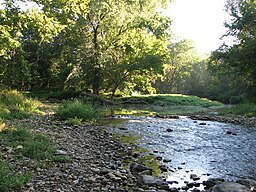White Clay Creek Preserve
| White Clay Creek Preserve | |
| Pennsylvania State Park | |
|
Confluence of the East and Middle Branches White Clay Creek, in the Preserve.
|
|
| Named for: White Clay Creek | |
| Country | United States |
|---|---|
| State | Pennsylvania |
| County | Chester |
| Township | London Britain |
| Location | |
| - elevation | 253 ft (77 m) |
| - coordinates | 39°44′35″N 75°47′21″W / 39.74306°N 75.78917°WCoordinates: 39°44′35″N 75°47′21″W / 39.74306°N 75.78917°W |
| Area | 1,255 acres (508 ha) |
| Founded | 1984 |
| Management | Pennsylvania Department of Conservation and Natural Resources |
| IUCN category | III - Natural Monument |
| Website: White Clay Creek Preserve | |
White Clay Creek Preserve is a 1,255-acre (508 ha) Pennsylvania state park along the valley of White Clay Creek in London Britain Township in Chester County, Pennsylvania in the United States. The park was donated by the DuPont Company in 1984 for the purpose of "preserving the diverse and unique plant and animal species, and the rich cultural heritage of the area". Dupont also donated an additional 528 acres (214 ha) for the adjoining White Clay Creek State Park to the state of Delaware. White Clay Creek Preserve is 3 miles (4.8 km) north of Newark, Delaware on Pennsylvania Route 896.
The land on which White Clay Creek Preserve is located was originally sold to William Penn by Lenape Chief Kekelappen in 1683. Historians believe that Chief Kekelappen may have lived in Opasiskunk an Indian town that was at the confluence of the east and middle branches of White Clay Creek. This town was quite large and covered several acres. Archeologists have found evidence that Opasiskunk was inhabited from the Archaic Period until the early 18th century.
There are several buildings from the early colonial era still standing in the vicinity of White Clay Creek Preserve. The Yeatman Mill House was once the hub of a prosperous milling and agriculture complex during the 18th and 19th centuries. The London Tract Baptist Meetinghouse was built in 1729. It is at the intersection of Sharpless and London Tract roads. Many of the area's earliest settlers are buried in the cemetery of the church.
...
Wikipedia


